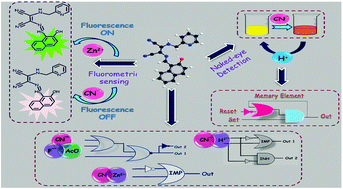Studies on a multifunctional chromo-fluorogenic sensor for dual channel recognition of Zn2+ and CN− ions in aqueous media: mimicking multiple molecular logic gates and memory devices†
Abstract
A new effectual naphthalene-based azomethine receptor has been systematically designed and synthesized as a selective colorimetric and fluorescent chemosensor for dual channel detection of cations and anions in aqueous environments. Moreover, the outstanding spectral responses of the devised probe prompted us to fabricate multifunctional molecular logic circuits. Importantly, the introduction of electron-withdrawing nitrile moieties into the backbone of the molecule makes the receptor an efficient tool for detection of toxic cyanide in semi-aqueous media even in the presence of other plausible interfering anions including fluoride and acetate. In particular, addition of KCN to an aqueous solution of the sensor visibly changes the colour from light yellow to orange, enabling naked-eye CN− sensing without resorting to any spectroscopic instrumentation. On the other hand, the fluorescence intensity of the receptor at 540 nm was drastically quenched with a strong signature of a redshift of the emissions. Besides, the mechanism of operation was carefully elucidated via spectroscopic methods. Apart from this, the target receptor exhibited fluorescent enhancement and colour change upon the addition of Zn2+ ions attributed to the CHEF (chelation-enhanced fluorescence) process in aqueous media. To our surprise, the detection limit of the sensor for zinc ions was (0.11 μM) far below the guidelines of the World Health Organization (WHO) (76 μM) for the maximum allowable zinc concentration in drinking water. Successfully, according to the changes in absorption outputs in pure DMSO at particular wavelengths in response to the set of anions (CN−, AcO− and F−) as input variables, the function of a 3-input logic circuit composed of OR, NOR and NOT gates has been demonstrated. Subsequently, based on the fascinating on–off switching behavior, a complementary IMP/INH logic gate with the complicated function of a memory device can be represented by employing CN− and H+ as chemical inputs. In accession, according to the emission changes, an IMPLICATION logic gate was elaborated in response to CN− and Zn2+ as two ionic inputs.



 Please wait while we load your content...
Please wait while we load your content...